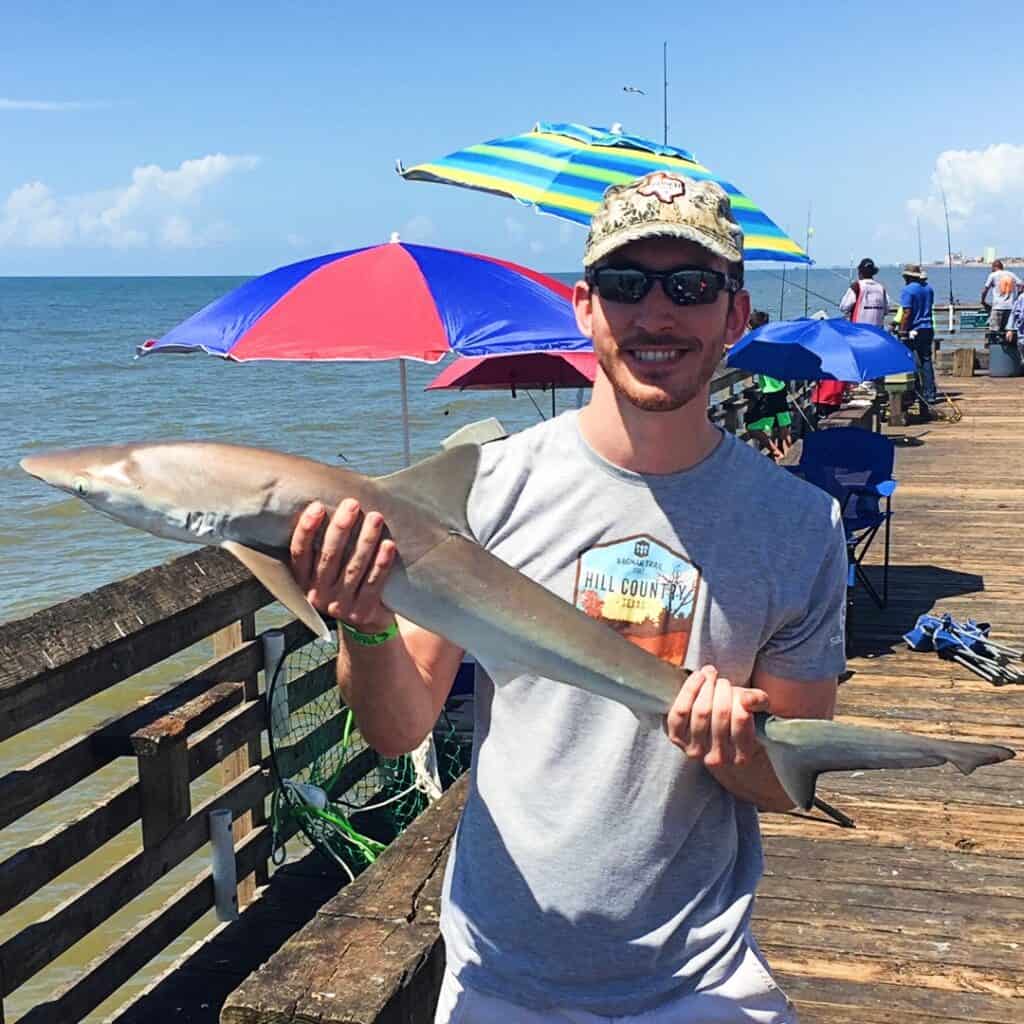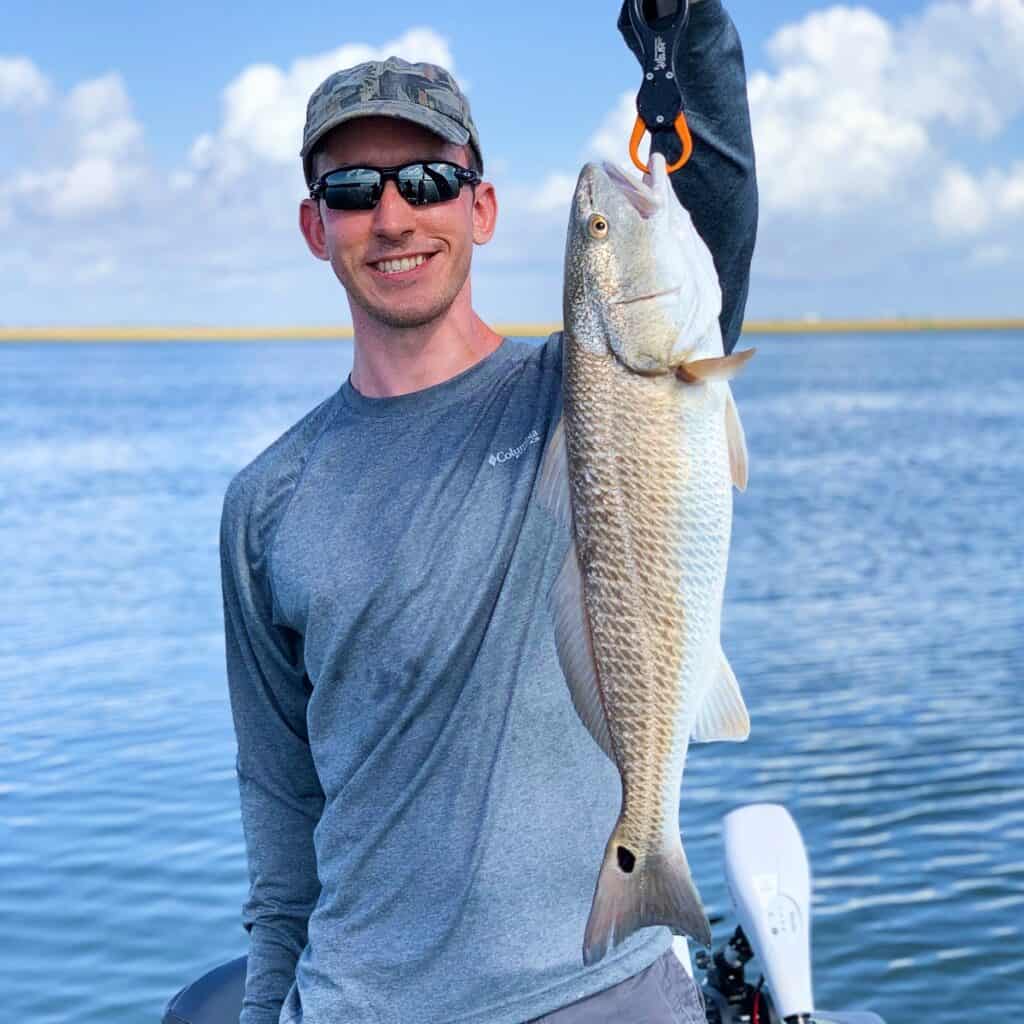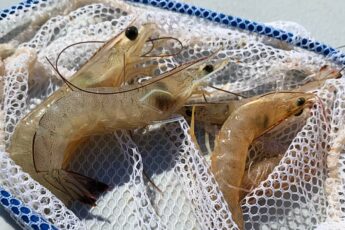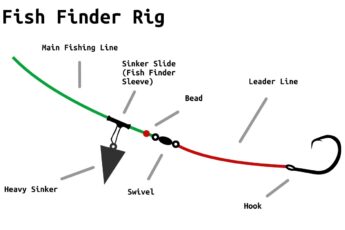Surf fishing is land-based or wade fishing performed on the shoreline of a sea or ocean. Surf fishing is usually directly from the beach but could include fishing from jetties or ocean piers.
At its best, surf fishing can be an adrenaline packed fishing bonanza where you can catch some of the biggest fish on the planet. Just about anyone can appreciate a 3-foot long bull red doing its best to pull you into the ocean.

Surf fishing is deceptively simple. Just throw some bait out and catch huge fish, right?
Wrong! Consistently catching fish while surf fishing requires key knowledge on how surf fish species move and feed plus specialized fishing equipment to get your bait into the strike zone.
Fortunately, this ultimate guide will teach you everything you need to know on how to surf fish.
*Disclosure: I only recommend products I would use myself and all opinions expressed here are my own. This post may contain affiliate links that at no additional cost to you, I may earn a small commission.
Table of Contents
- Where to Surf Fish
- Surf Fishing Equipment
- Surf Fishing Bait
- What Can You Catch Surf Fishing?
- When to Surf Fish?
- Conclusion
Where to Surf Fish
Surf fishing includes fishing from ocean piers, jetties, and directly from the beach. While the surf holds an abundance of sea critters, the old fishing adage holds true for surf fishing too:
90% of the fish are in 10% of the water.
Knowing where to cast and what to look for are critical for surf fishing success.
Reading the Surf
The water near the beach hides a surprising amount of subsurface structure. Wind and wave action are constantly shifting sand, bait, and game fish around. Experienced surf anglers know how important it is to be able to read the surf.

Most beaches have 1 to 3 sets of sandbars or shoals (and corresponding troughs) running parallel to the shore. These comparatively shallower sandbars can be identified by where the waves crash. Immediately inshore and offshore of these sandbars are deeper troughs that act as highways for cruising fish.
There can be gaps, or cuts, between sandbars that let water flow back off the beach after waves crash. These cuts can cluster fish looking to pass through or feed on the bait being pushed around by waves and current.
Where to Cast Surf Fishing
The best place to cast while surf fishing is the troughs adjacent to the sandbars running parallel to the shoreline. Fish cruise up and down the deeper water in these troughs looking for food and shelter.

The turbulence of the waves around these troughs and sandbars also stirs up baitfish and crustaceans creating a buffet for larger fish.
For jetties or piers, I try a few different strategies until I find fish. First, I cast near the pier pilings or rocks close by to see if fish are hugging tight to structure. From there, I start looking for the deepest nearby water. Also, keep an eye on local anglers – they may know about secret underwater structure and you can pick up tips and tricks from them.

Watch for feeding birds, bait activity on the surface, or slicks. Slicks look like mini oil slicks and are caused by active feeding game fish, commonly speckled trout, regurgitating oily baitfish.
Surf Fishing Equipment
Bigger is generally better for surf fishing equipment. The key factor for surf fishing is whether you can cast to the troughs near the sand bars. Casting distance is key, and that is why surf fishing rods are much longer than normal rods. Surf fishing rods are usually between 8 and 15 feet. It is common to need to cast 50 to 100 yards while surf fishing.
Other factors to consider are the size of target fish species. Beach fish are some of the biggest around, and require larger baits and reels to effectively catch.
Best Surf Rod for Surf Fishing
The best rod for surf fishing for most people is a 10 to 12 foot surf rod with medium to medium-heavy power and moderate to fast action. This type of rod can cast far enough to reach the current troughs in the surf that fish frequent, and have enough backbone to reel in big surf species.
Considerations for surf rods should include length, quality of rod materials because the rod will be exposed to corrosive saltwater, handle type, rod material, rod power, rod action, and portability. Check out our article on the best surf fishing rods available for a deep dive review.
Best Surf Reel for Surf Fishing
The best reel for surf fishing for most people is a saltwater rated spinning reel in the 4000 to 6500 size range. These reels are large enough to handle big surf fish species and can hold enough line to allow surf anglers to cast as far as the long surf rods will allow.
Saltwater rated reels are manufactured with higher quality materials and are less prone to corrosion from saltwater exposure. Don’t forget to rinse your reel with freshwater after every fishing trip to help prolong its life!
The best surf fishing line to spool on your reel is 20 to 40 lb braid. Braid is a great option because it has a smaller diameter at the same strength compared to mono. This means you can fit more braid on your reel which is important for the long casting distances required for surf fishing.
Use heavier braid if targeting bull reds or sharks, or go lighter for most everything else. The smaller the diameter of the line, the less the wind and current will try and push your line around.
Check out our article on the best surf fishing reels for more information!
Best Fishing Accessories for Surf Fishing
Surf fishing can be gear intensive. Surf anglers may elect to bring the following accessories:
- Surf fishing cart
- Rod Holders
- Fillet Knife
- Tackle Box and associated gear
- Fishing Pliers
- Bait Bucket
- Cooler with wheels
- Chairs
- Cast Net
Most important for me are generally rod holders, a place to sit, and a stocked tackle box. Bring a cooler with ice to keep anything you catch fresh.
Best Bait for Surf Fishing
Live Bait
Many surf anglers use live bait. The most common types are live shrimp, cut bait, squid, sand fleas, and crabs. Check out our article on the best surf fishing baits for a deep dive breakdown.
Live bait is usually hooked on a circle hook on a bottom rig like a fish finder rig or Carolina rig. Since the waves and current will do their best to move your bait around, it is common to use weights between 1/2 to 4 oz while surf fishing. Also, these heavier weights also make it easier to cast long distances.
Popping corks can also be effective in the surf. Live shrimp under a cork is a classic pairing. Cast out your popping cork and periodically pop it with a quick jerk of the rod top. When a hungry fish inhales your bait, they will pull the cork underwater. Set the hook!
Artificial Bait
Alternatively, surf fishing is also effective with artificial baits. Surf fishing artificial baits are usually spoons, jigs, or plugs. Spoons are silver or gold chunks of metal that flutter as they are reeled in. Jigs are weighted hooks tipped with soft plastic artificial baits like paddletails or curly tailed grubs. Lastly, plugs are hard-bodied fishing lures that resemble baitfish or crustaceans.
Artificial baits are casted and retrieved while live baits are generally cast and left until a fish strikes.
What can you catch surf fishing?
Commonly pursued fish species per region include:
Texas / Gulf Coast
- Flounder
- Red Drum (Redfish)
- Speckled Trout
- Black Drum
- Sheepshead
- Sharks

Florida
- Snook
- Pompano
- Snapper
- Black Drum
- Red Drum (Redfish)
- Permit
- Whiting
- Tarpon
- Bluefish
- Spanish Mackerel
- Sharks
Atlantic Coast
- Red Drum (Redfish)
- Striped Bass
- Black Drum
- Bluefish
- Cobia
- Pompano
- Flounder
- Mackerel
- Sheepshead
- Speckled Trout
- Sharks
California
- Barred, Walleye, Calico, Redtail, or Silver Surfperch
- Striped Bass
- California Halibut
- Jacksmelt, Surf Smelt, and Night Smelt
- Leopard Sharks
When to Surf Fish
Surf fishing can be effective most times of day, but certain weather conditions, tides, and water conditions can increase the chances of success.
Best Time to Surf Fish
Most anglers consider the low light conditions of dawn and dusk as the best time to surf fish. Fish are frequently actively feeding during these times. That said, surf fish can be caught any time of the day.
Water clarity can be a key factor as well. Wind direction and tides can push muddy water near shore that can negatively affect surf fishing. Clearer water is considered better.
Best Conditions for Surf Fishing
Surf fishing conditions can vary significantly. Water clarity, seaweed quantities, surf height, wind, air temperature, water temperature, and tides all affect chances of success.
I believe weather and tidal conditions are most important for surf fishing.
Weather
Generally, calmer conditions are better for surf fishing. Waves on the beach are created mainly due to wind shear force on the water, and the calmer the surf, the easier it can be to get your bait into the right areas and find fish.
Match your bait to the conditions. ‘Loud’ baits with a lot of movement and flash are better in rougher conditions and neutral colors with a more subtle presentation are better for calm conditions and clear water.
Tides
I look for two things related to tides for surf fishing. Moving water (applicable to both rising and falling tides), and tidal height. Not all tides are created equal, and variable tidal height means certain structure like rocks, reefs, or shell only have optimal conditions during certain tides.
Conclusion
Surf fishing is a great way to enjoy time at the beach and catch some of the biggest fish around. Understanding surf fish habits and how to read the beach are critical to the surf angler’s chance of success. Additionally, having the fit for purpose equipment, like surf fishing rods designed to cast long distances, are key to getting bait out to where the fish are feeding.
Above all, get out there and have fun!

Written By: Andrew Juran
Andrew is a seasoned angler with over 25 years of experience fishing across the United States. He has caught hundreds of fish using various techniques and mentored many in the art of fishing. An advocate for sustainable fishing, Andrew is an active member of the Coastal Conservation Association, an organization committed to marine conservation.
For frequent fishing tips, behind-the-scenes looks, and real-time catches, connect with Andrew on Instagram






